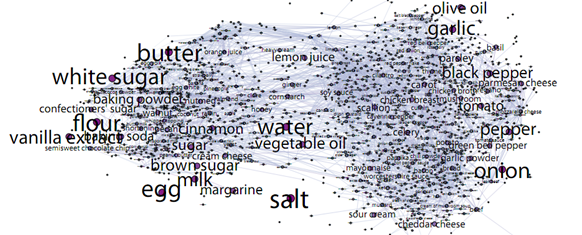Recipe Networks Reveal Human Taste Preferences
Napoleon famously remarked that an army marches on its stomach. So it’s no surprise that the U.S. military carries out a significant amount of research on food science. In the past, this has produced classic dishes such as the indestructible sandwich and the vitamin patch.

Today, Chun-Yuen Teng at the University of Michigan and colleagues use funding from the U.S. Air Force and Army to distill the world’s collective wisdom on how to combine ingredients. They’ve done this simply by studying the relationships between some 46,000 recipes on the Allrecipes.com website.
These guys used this data to create two networks. The first consists of ingredients used in the same recipes—the strength of a link between two ingredients depends on the probability that they occur together against the probability that they occur separately. This network divides into two main communities corresponding to sweet and savoury dishes, although there are other smaller clusters such as one that corresponds to mixed drinks with ingredients such lime, rum, ice, orange and so on.
The second is a substitution network which contains ingredients that can be substituted for others (for example, apple sauce as a low fat alternative to oil).
While much of the data comes from the recipes themselves, Teng and co also extract some significant info from the ratings that users give each recipe and the comments they add, such as “I replaced the butter in the frosting by sour cream, just to soothe my conscience about all the fatty calories.”
The result is a fascinating insight into the nature of cooking. One of their approaches is to examine regional differences in cooking methods. Of the US, they conclude that: “Boiling and simmering are more common in the South and Midwest. Marinating and grilling are relatively more popular in the West and Mountain regions. Frying is popular in the South and Northeast.” That could allow meals to be better targeted at people from specific regions.
But they offer more profound insights too. Evolutionary biologists have long suspected that cooking played an important role in human evolution. Various lines of evidence suggest that the metabolism can extract more energy from mechanically ground food, even more from cooked food and still more from food that has been both mechanically prepared and cooked. These processes reduce the digestive cost of the food to the body and release extra energy for our power-hungry brains.
So an interesting question is whether this process has left its mark on our preference for foods prepared in different ways. Sure enough, Teng and co find that it has by looking at the relationship between ratings and food preparation techniques. They say that food that is prepared in a way that reduces its digestive cost consistently gets the highest ratings.
They then go on to use this finding to predict which recipes are likely to get the best ratings.
That should help meal planners produce better meals that are likely to be rated more highly by the consumers.
It also suggests some interesting lines for future research. Teng and co want to look at region and diet-specific ratings and to automatically suggest alternative ingredients in existing recipes. It might also help them look for unexplored pathways in these networks that could produce entirely new combinations of foods and flavours.
Clearly there’s never been a better time for an army to march on its stomach.
Ref: arxiv.org/abs/1111.3919: Recipe Recommendation Using Ingredient Networks
Keep Reading
Most Popular
Large language models can do jaw-dropping things. But nobody knows exactly why.
And that's a problem. Figuring it out is one of the biggest scientific puzzles of our time and a crucial step towards controlling more powerful future models.
How scientists traced a mysterious covid case back to six toilets
When wastewater surveillance turns into a hunt for a single infected individual, the ethics get tricky.
The problem with plug-in hybrids? Their drivers.
Plug-in hybrids are often sold as a transition to EVs, but new data from Europe shows we’re still underestimating the emissions they produce.
Google DeepMind’s new generative model makes Super Mario–like games from scratch
Genie learns how to control games by watching hours and hours of video. It could help train next-gen robots too.
Stay connected
Get the latest updates from
MIT Technology Review
Discover special offers, top stories, upcoming events, and more.